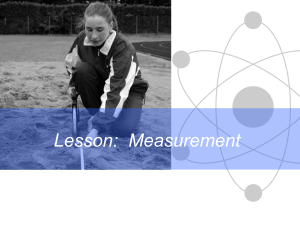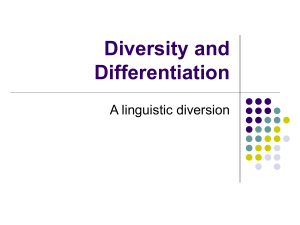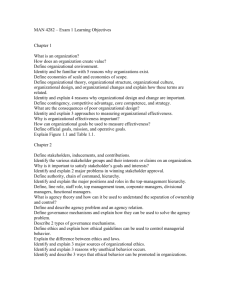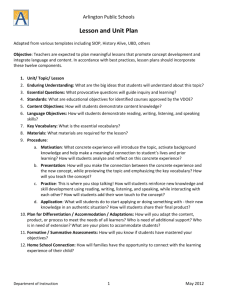SEND/ Using other adults effectively
advertisement
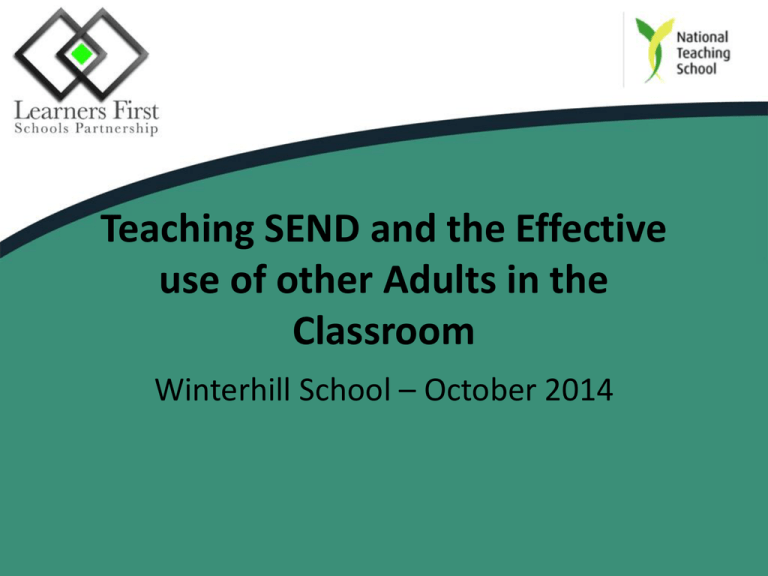
Teaching SEND and the Effective use of other Adults in the Classroom Winterhill School – October 2014 Introduction • Richard Pearson (Senior Mentor Co-ordinator/SLE) • Andrew Reeder (Assistant Headteacher/SLE) Where are you? • Task – Perform the SEND Audit • Quality first teaching of students with a SEND profile avoids a deficiency model of planning and teaching delivery Inclusive Teaching • Creates a culture of high expectation for all • Emphasises what a student will learn, NOT what activity they will do • Plans based on a sound assessment of what the student already knows, understands and can do • Uses teaching styles that meet the needs of individuals and groups so that all students are engaged in learning. • Develops access strategies to ensure that potential barriers to learning and progress are minimised. Circles of Inclusion Responding to student’s diverse needs LEARNING OBJECTIVES TEACHING STYLES Setting suitable learning challenges ACCESS Overcoming potential barriers to learning Waves of intervention Wave 3 Highly personalised interventions Wave 2 Additional interventions to enable students to work at age related expectations or higher Wave 1 Quality first teaching -effective differentiation Copy from the board please... Dyslexia- challenges • • • • • • • • • • Reading, spelling, handwriting Sequencing skills Short-term memory Confusion about left and right Reading comprehension, phonological awareness Mathematical problem solving Musical notation Expressing thoughts orally Personal organisation skills Auditory and visual processing Moderate Learning Difficulties • General (global) developmental delay. • Largest SEN group in mainstream schools. • Difficulties with learning across several areas e.g. learning, speech, self-help, social. • Many of these students have a delay of about three years and consequently need a high level of support within the mainstream classroom and many opportunities for overlearning . Autistic Spectrum – challenges • • • • • • • • Making and sustaining friendships Using unstructured time Awareness of others/perception Change working in groups Anxiety Sensory sensitivity Imagination/taking things literally Asperger’s syndrome – Student Voice Alexander is 11 and was diagnosed with Asperger syndrome when he was nine. He attends a mainstream primary school with a minimum of help and is very bright academically, but he has some motor skills and social skills difficulties. He is very sensitive to noise, but has learned to cope. He only had one good friend at school who moved away two years ago. Every SEND student is unique Teach the Student not the Label • The ‘Label’ will give you guidance for differentiation but will not give you the whole picture to support effective inclusive teaching • Ask the student what helps or hinders their learning • Collect perspective from parents or carers • Be prepared to experiment with approaches and strategies and log positive or negative responses. What am I? Dyscalculia • Link maths to relevant and practical contexts – shopping, eating out etc. • Use a ‘scaffolding’ approach – avoid rushing the student through a task. Break it down into steps. Provide time for recap & consolidation at each stage and revisit the basic skills often • Use small numbers when introducing new concepts. Gradually work up to higher numbers via short, small step tasks • Use a variety of visual and kinaesthetic resources – objects, images and models. Allow the students to manipulate the resources • Use a variety of visual and kinaesthetic resources – objects, images and models. Allow the students to manipulate the resources What am I? ASD • Teach/use very clear classroom routines, e.g. lining up at the start, equipment check, students holding an object when it is their turn to talk. • Use student’s name before asking a question or giving an instruction • Set explicit and clear expectations e.g. how may lines to write, how many questions to answer, how long to listen (use timer) • Avoid or explain metaphorical language and idiom like ‘pull your socks up’, ‘it’s raining cats and dogs’, ‘in a minute’ • Set tasks with clear goals (“Write three sentences on” rather than “Write about…”) and write worksheets in step-by-step form What am I? Visual Impairment • Seat students in the middle at the front (first or second row), this helps them to use their hearing to listen to what you are saying. • Sit the student next to peers they can work well with - they will need to ask questions from time to time, a helpful partner is worth their weight in gold. • Try to have a quiet working environment • Speak clearly with extended natural pauses • Say the student’s name before asking a direct question or giving a direct instruction and indicate who is talking in a class discussion. • Avoid clutter or busy displays around the whiteboard area What am I? ADHD • Seat student in an area of the classroom free from busy displays and distractions. Try to keep the area around the whiteboard / IWB ‘clutter free’ • During teacher-talk, allow the student to fiddle with a piece of blu-tac, rubber band, squeeze ball or another chosen object whilst maintaining eye contact • Give instructions simply and clearly. Make sure the student is looking at you first. Check that he or she has understood them • Try to seat the student well away from areas other students need to walk through. Also try to limit opportunity for them to ‘roam’ around the classroom (such as handing out books etc.) • Use a timer to help the student complete a task in a specified period of time. • Actively teach/use clear classroom routines, e.g. have all students hold an object when it is their turn to talk OFSTED – to be ‘GOOD’ Teaching in most subjects, including English and mathematics, is usually good, with examples of some outstanding teaching. As a result, most pupils and groups of pupils on roll in the school, including disabled pupils, those who have special educational needs, those for whom the pupil premium provides support and the most able, make good progress and achieve well over time. Key Questions Know your students! • Prior learning • Target level or grade • SEN or G & T • Skills and knowledge required to reach or exceed target Know where you want to go to • What are your objectives for the lesson? • ‘All’ ‘Most’ ‘Some’ ? • Support? • Extension: quality not quantity • How will students be grouped? Differentiation – Progress for All Most Common Types • By outcome • By task • By questioning • By support Further Details Differentiation by Outcome • All students complete same task • The resulting work is at a number of different levels reflecting the individual student’s ability (?) • Examination task • Suitable in the teaching process? • Best from students? Differentiation by Task • Language • Activities • Teaching methods • Thinking processes Differentiation by Questioning Higher order thinking skills Blooms Taxonomy Evaluation Synthesis Analysis Application Comprehension Knowledge Lower order thinking skills Differentiation by Support • Some students need more help than others to complete the task • The amount and degree of help provided can be differentiated to meet the needs of individual students • This support can be provided by the teacher or by other adults • The support could come from other students • ICT • An able pupil could be supported by an independent learning package Case Studies • Task – You are teaching one of the lessons from the schemes of work – You have been given a student profile – Complete the lesson plan to show how could adapt the lesson to ensure that student makes good progress Student Profile Lesson Plans What OFSTED says: Paper presented at the British Educational Research Association Annual Conference, University of Glamorgan, 14-17 September 2005 Danny Durant (Adviser) and Julien Kramer (Director of Education) Worcestershire LEA Some strategies: Evaluation THANK YOU FOR YOUR PARTICIPATION THIS EVENING Next Steps • What 3 things are you going to use in your next lesson? • Can you reflect on something you have done/or seen a colleague do and suggest some changes?






